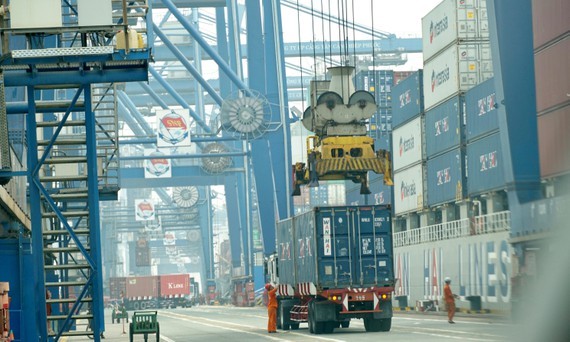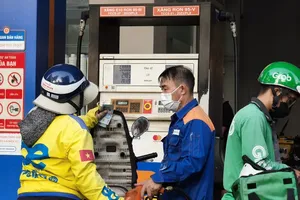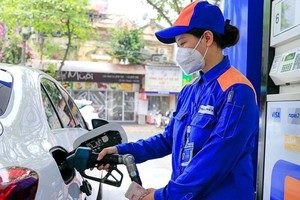 Goods for export are loaded onto vessels at Tan Cang Hiep Phuoc Port in Nha Be District. (Photo: SGGP)
Goods for export are loaded onto vessels at Tan Cang Hiep Phuoc Port in Nha Be District. (Photo: SGGP)
Opportunities for Vietnamese goods
According to the Trade Promotion Agency, recently, through many online trade promotion and connection activities, the agency has received many orders from foreign enterprises, with most orders from Europe, Japan, South Korea, the US, and Middle East countries. They need the supply in large quantities of agricultural products, seafood, food, and processed food.
Many enterprises in Osaka, Japan, which import and distribute agricultural products, raw materials for the production of spices and processed foods of all kinds, need to find Vietnamese partners to supply the apple jam product. These Japanese companies are looking for partners capable of producing high-quality goods that meet quality standards and production processes and ensure a stable supply of 100 - 120 tons of goods per year.
In the European market, right after the online consultation session on exporting agricultural and aquatic products to the Netherlands, which took place on August 9, the Trade Promotion Department has received many orders from enterprises from this market. Earlier, the Vietnam Trade Office in the United Kingdom also held an online seminar to introduce Vietnamese agricultural products and fruits in the UK market.
Mr. Kevin, a representative of Birmingham Market in the UK, affirmed that the market welcomes 5,000 visitors every day, consuming from tens to hundreds of tons of each type of agricultural products that are currently the key export products of Vietnam, such as banana, dragon fruit, mango, avocado, lychee, longan, jackfruit, passion fruit, and pineapple. Currently, the average annual export turnover of Vietnam's agricultural and aquatic products to the UK exceeds US$6 billion. Exports will be expanded further soon when the EU-Vietnam Free Trade Agreement (EVFTA) has been taking advantage of by domestic enterprises.
At the online consultation session to support enterprises to boost exports to the Dutch market in particular and Europe in general, Ms. Nguyen Thi Thu Thuy, Deputy Director of the Export Support Center under the Trade Promotion Agency, said that many Vietnamese agricultural, aquatic, and seafood processing enterprises have had long-term export experience to the European market, so technical barriers cannot cause them difficulties. Moreover, August 2021 marks the first anniversary of the signing of the EVFTA between Vietnam and the EU. On that basis, the two core factors for Vietnamese agricultural and aquatic products to take full advantage of the tax rate preference are ensuring the rules of origin and meeting the European quality standards. Domestic enterprises have made the most of these two factors to increase the competitive advantage of Vietnamese goods in this market.
Statistics of the first six months of this year of the MoIT show that, after the EVFTA took effect, the bilateral trade turnover of Vietnam and the EU reached $3.3 billion, up 28 percent over the same period, despite the outbreak of the Covid-19 pandemic. It not only helps domestic enterprises to gain footholds in the European market but also creates a solid foundation in production technology standards and product quality, enough for them to enter the fastidious export markets later.
Proposal for quick deployment of two-on-site model
Many domestic enterprises could not receive new orders due to congestion of goods circulation in some provinces, cities, and seaports. Especially, enterprises have had to reduce their production capacity by 50 percent or cease operations to ensure safety against the Covid-19 pandemic.
Many enterprises have proposed to the authorities to quickly deploy the conditional two-on-site production model in order not to miss business opportunities.
According to Ms. Ly Kim Chi, Chairwoman of the Food and Foodstuffs Association of HCMC, this model is especially suitable for the condition that the city has a large number of boarding houses for workers near the factories. Business owners will work with the owners of boarding houses to tighten safety on Covid-19 prevention and control, and at the same time, assign employees to control the movement of workers after work. Workers must commit to staying home after work. Enterprises will organize busses to transport workers from the factory to the place of residence. It will reduce cost pressure for businesses and make workers more comfortable.
Moreover, the trade of goods, especially at ports, is extremely important. According to the HCMC Union of Business Association, Tan Cang Cat Lai Port has applied many solutions to prevent overload, such as transporting goods to satellite ports, shortening procedures, and reducing service fees. However, these are short-term solutions, and it is essential to have more effective measures. For instance, the import and export procedures should be simplified to help goods jammed at the port move quickly.
According to the Trade Promotion Agency, recently, through many online trade promotion and connection activities, the agency has received many orders from foreign enterprises, with most orders from Europe, Japan, South Korea, the US, and Middle East countries. They need the supply in large quantities of agricultural products, seafood, food, and processed food.
Many enterprises in Osaka, Japan, which import and distribute agricultural products, raw materials for the production of spices and processed foods of all kinds, need to find Vietnamese partners to supply the apple jam product. These Japanese companies are looking for partners capable of producing high-quality goods that meet quality standards and production processes and ensure a stable supply of 100 - 120 tons of goods per year.
In the European market, right after the online consultation session on exporting agricultural and aquatic products to the Netherlands, which took place on August 9, the Trade Promotion Department has received many orders from enterprises from this market. Earlier, the Vietnam Trade Office in the United Kingdom also held an online seminar to introduce Vietnamese agricultural products and fruits in the UK market.
Mr. Kevin, a representative of Birmingham Market in the UK, affirmed that the market welcomes 5,000 visitors every day, consuming from tens to hundreds of tons of each type of agricultural products that are currently the key export products of Vietnam, such as banana, dragon fruit, mango, avocado, lychee, longan, jackfruit, passion fruit, and pineapple. Currently, the average annual export turnover of Vietnam's agricultural and aquatic products to the UK exceeds US$6 billion. Exports will be expanded further soon when the EU-Vietnam Free Trade Agreement (EVFTA) has been taking advantage of by domestic enterprises.
At the online consultation session to support enterprises to boost exports to the Dutch market in particular and Europe in general, Ms. Nguyen Thi Thu Thuy, Deputy Director of the Export Support Center under the Trade Promotion Agency, said that many Vietnamese agricultural, aquatic, and seafood processing enterprises have had long-term export experience to the European market, so technical barriers cannot cause them difficulties. Moreover, August 2021 marks the first anniversary of the signing of the EVFTA between Vietnam and the EU. On that basis, the two core factors for Vietnamese agricultural and aquatic products to take full advantage of the tax rate preference are ensuring the rules of origin and meeting the European quality standards. Domestic enterprises have made the most of these two factors to increase the competitive advantage of Vietnamese goods in this market.
Statistics of the first six months of this year of the MoIT show that, after the EVFTA took effect, the bilateral trade turnover of Vietnam and the EU reached $3.3 billion, up 28 percent over the same period, despite the outbreak of the Covid-19 pandemic. It not only helps domestic enterprises to gain footholds in the European market but also creates a solid foundation in production technology standards and product quality, enough for them to enter the fastidious export markets later.
Proposal for quick deployment of two-on-site model
Many domestic enterprises could not receive new orders due to congestion of goods circulation in some provinces, cities, and seaports. Especially, enterprises have had to reduce their production capacity by 50 percent or cease operations to ensure safety against the Covid-19 pandemic.
Many enterprises have proposed to the authorities to quickly deploy the conditional two-on-site production model in order not to miss business opportunities.
According to Ms. Ly Kim Chi, Chairwoman of the Food and Foodstuffs Association of HCMC, this model is especially suitable for the condition that the city has a large number of boarding houses for workers near the factories. Business owners will work with the owners of boarding houses to tighten safety on Covid-19 prevention and control, and at the same time, assign employees to control the movement of workers after work. Workers must commit to staying home after work. Enterprises will organize busses to transport workers from the factory to the place of residence. It will reduce cost pressure for businesses and make workers more comfortable.
Moreover, the trade of goods, especially at ports, is extremely important. According to the HCMC Union of Business Association, Tan Cang Cat Lai Port has applied many solutions to prevent overload, such as transporting goods to satellite ports, shortening procedures, and reducing service fees. However, these are short-term solutions, and it is essential to have more effective measures. For instance, the import and export procedures should be simplified to help goods jammed at the port move quickly.
























